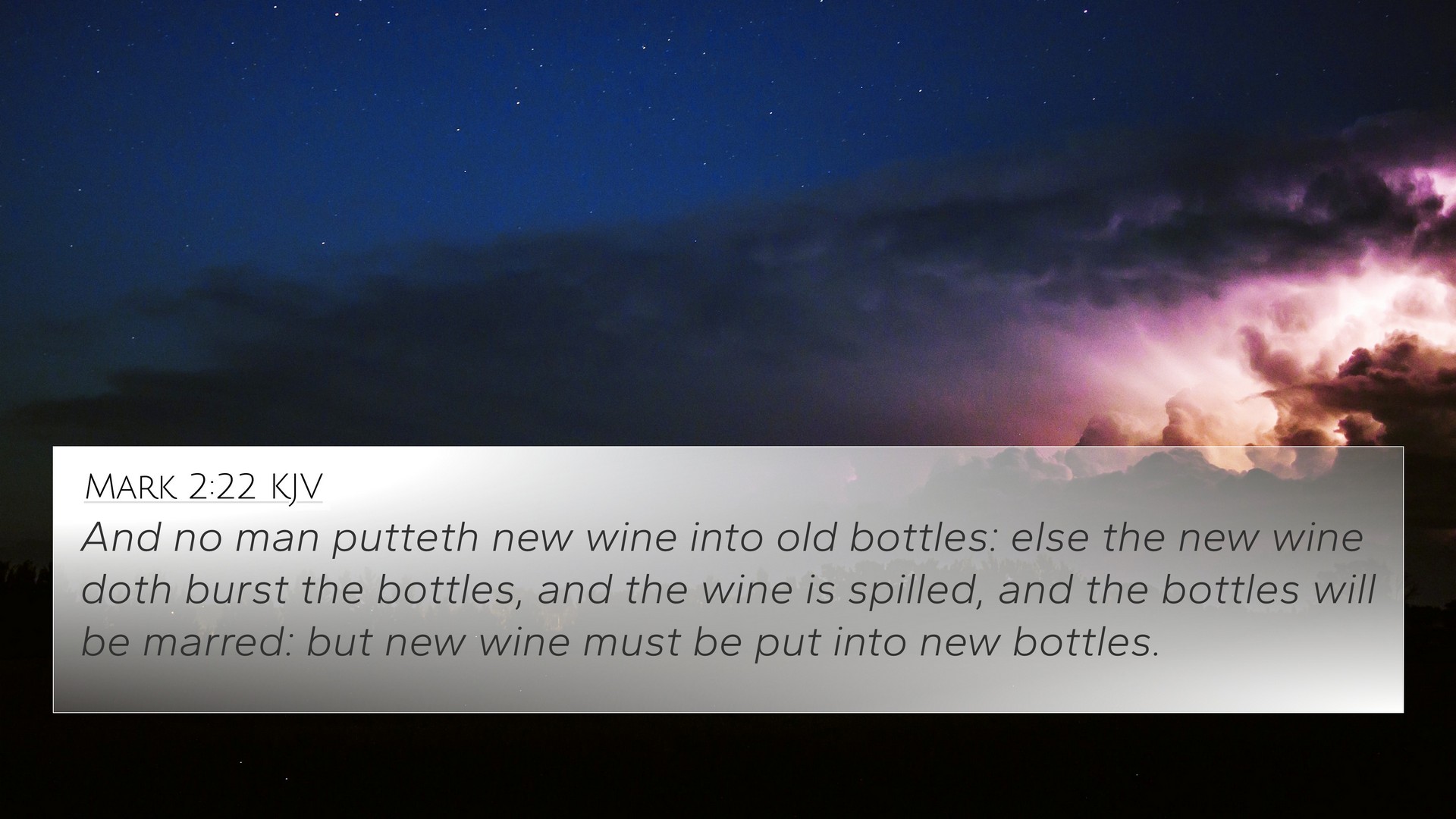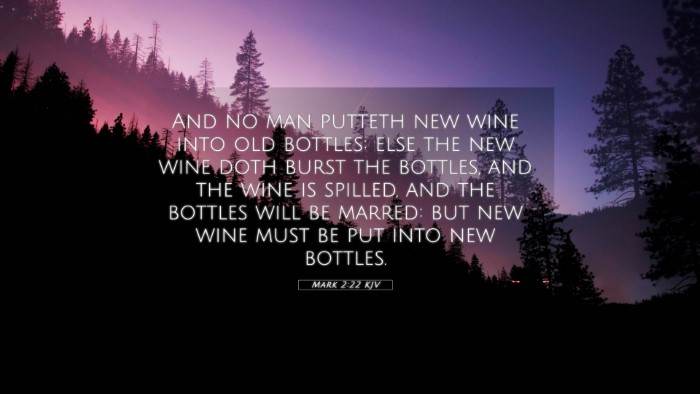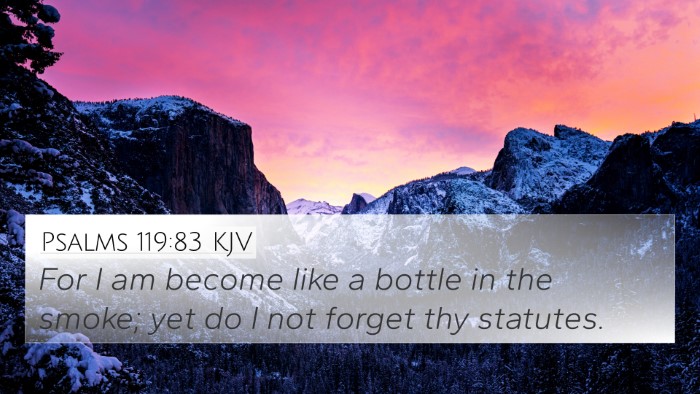Old Testament
Genesis Exodus Leviticus Numbers Deuteronomy Joshua Judges Ruth 1 Samuel 2 Samuel 1 Kings 2 Kings 1 Chronicles 2 Chronicles Ezra Nehemiah Esther Job Psalms Proverbs Ecclesiastes Song of Solomon Isaiah Jeremiah Lamentations Ezekiel Daniel Hosea Joel Amos Obadiah Jonah Micah Nahum Habakkuk Zephaniah Haggai Zechariah MalachiMark 2:22 Similar Verses
Mark 2:22 Cross References
And no man putteth new wine into old bottles: else the new wine doth burst the bottles, and the wine is spilled, and the bottles will be marred: but new wine must be put into new bottles.
Uncover the Rich Themes and Topics of This Bible Verse
Listed below are the Bible themes associated with Mark 2:22. We invite you to explore each theme to gain deeper insights into the Scriptures.
Mark 2:22 Cross Reference Verses
This section features a detailed cross-reference designed to enrich your understanding of the Scriptures. Below, you will find carefully selected verses that echo the themes and teachings related to Mark 2:22 KJV. Click on any image to explore detailed analyses of related Bible verses and uncover deeper theological insights.
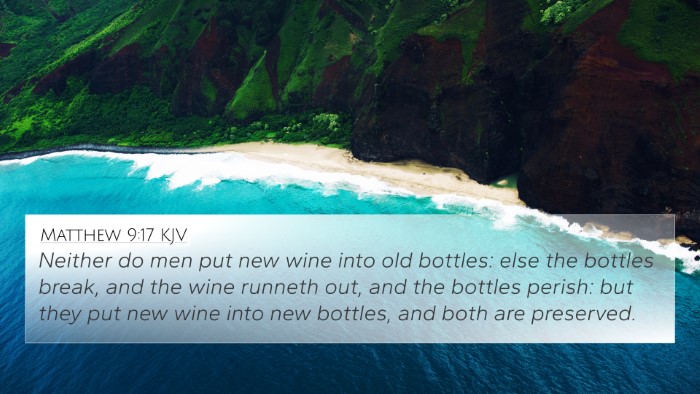
Matthew 9:17 (KJV) »
Neither do men put new wine into old bottles: else the bottles break, and the wine runneth out, and the bottles perish: but they put new wine into new bottles, and both are preserved.
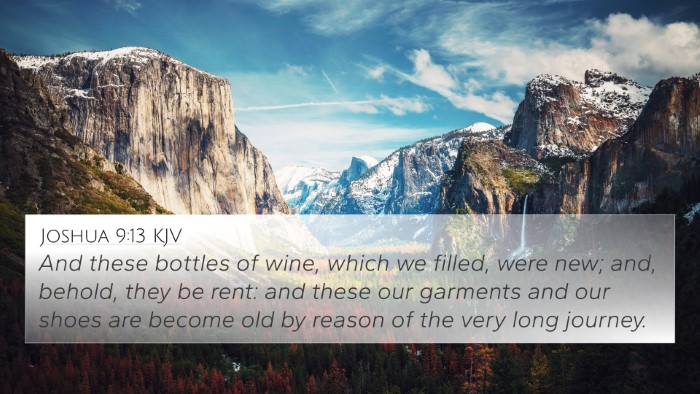
Joshua 9:13 (KJV) »
And these bottles of wine, which we filled, were new; and, behold, they be rent: and these our garments and our shoes are become old by reason of the very long journey.

Joshua 9:4 (KJV) »
They did work wilily, and went and made as if they had been ambassadors, and took old sacks upon their asses, and wine bottles, old, and rent, and bound up;

Job 32:19 (KJV) »
Behold, my belly is as wine which hath no vent; it is ready to burst like new bottles.
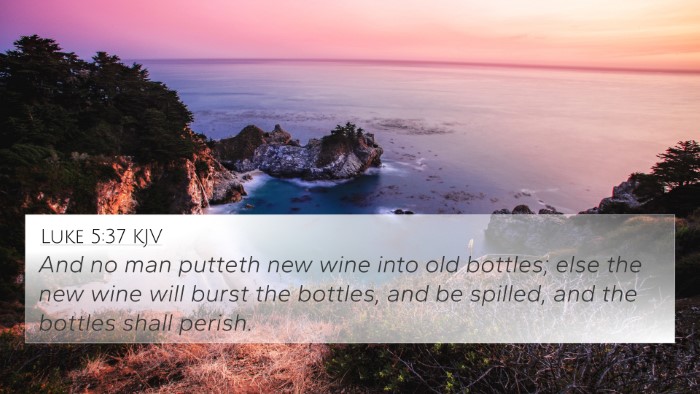
Luke 5:37 (KJV) »
And no man putteth new wine into old bottles; else the new wine will burst the bottles, and be spilled, and the bottles shall perish.
Mark 2:22 Verse Analysis and Similar Verses
Understanding Mark 2:22
Mark 2:22 states: "And no one puts new wine into old wineskins. If he does, the wine will burst the skins; and the wine is destroyed, and so are the skins. But new wine is for fresh wineskins." This verse utilizes the metaphor of new wine and old wineskins to express a significant spiritual truth. Below, we explore its meanings through the insights of established public domain commentaries.
Contextual Background
In this passage, Jesus is addressing the practices of fasting among His followers and contrasting them with the Pharisaic traditions. Matthew Henry emphasizes that Jesus introduces a new order that cannot simply be added to the old traditions. Instead, there must be a transformation.
Interpretive Insights
- Matthew Henry: Henry explains that the old wineskins represent the old covenant and Jewish traditions, which are incapable of containing the new teachings of Jesus. Like new wine, the Gospel requires a new understanding and way of life.
- Albert Barnes: Barnes elaborates that the process of fermentation signifies change and growth. He notes that trying to mix the teachings of Christ with traditional Judaism leads to a rupture of both the old and new. This indicates the incompatibility of Jesus's message with the rigid structures of the religious authorities of His time.
- Adam Clarke: Clarke underscores that the 'wineskins' symbolize the hearts and minds of the people. Those who cling to old ways will not understand or accept the new wine of Christ's teachings. He suggests that fresh receptivity is required for true spiritual growth.
Thematic Connections
This verse can be cross-referenced with numerous scriptural passages that explore similar themes of renewal and transformation, which are crucial in understanding the overarching message of the Gospel. Below are key connections:
- Matthew 9:17: This parallel verse conveys the same metaphor about new wine and old wineskins, directly affirming the message in Mark 2:22.
- Luke 5:37-38: Similar to the above, this scripture reiterates the necessity of new vessels for new teachings.
- 2 Corinthians 5:17: "Therefore, if anyone is in Christ, he is a new creation. The old has passed away; behold, the new has come!" This verse highlights the transformative power of accepting Christ.
- Galatians 5:1: This verse encourages freedom in Christ, suggesting that holding onto the old law is contrary to the new covenant.
- Romans 12:2: Paul urges believers to be transformed by the renewing of the mind, echoing the theme of change and receptivity to new truths.
- Hebrews 8:13: Refers to the obsolescence of the old covenant, emphasizing the establishment of a new covenant through Christ.
- Isaiah 43:19: "Behold, I am doing a new thing..." showcases God's promise of renewal, linking the concept of newness in both the Old and New Testaments.
Practical Applications
The insights gleaned from Mark 2:22 guide believers today in understanding the necessity for openness to God’s ongoing revelations and the need for spiritual renewal:
- Receptivity: Believers are called to remain open to new interpretations and understandings of scripture, as God continues to reveal His will.
- Transformation: The faithful must undergo radical changes in their lives and attitudes to fully embrace the Gospel and its implications.
- Separation from Tradition: Discerning the difference between beneficial traditions and those that hinder spiritual growth is essential for one's faith journey.
- New Practices: Embracing fresh spiritual practices that align with a relationship with Christ can lead to deeper faith.
Conclusion
Mark 2:22, when understood through the lenses provided by Matthew Henry, Albert Barnes, and Adam Clarke, invites us to ponder the transformation required in our lives to align with the message of Jesus. The metaphor of new wine and old wineskins encourages believers to let go of outdated practices that hinder spiritual growth and to embrace the newness of life offered through Christ. The thematic connections with other scriptures highlight a consistent biblical narrative about renewal and transformation.
Resources for Bible Cross-Referencing
For those looking to engage in a deeper study, utilizing tools such as a Bible concordance or a dedicated cross-reference guide is highly beneficial. These resources can aid in identifying parallels and connections among various scriptures, enhancing the understanding of biblical themes.
Suggested Further Reading and Study
If you are interested in exploring how to effectively use Bible cross-references and connect different scriptures, consider topics such as:
- How to find cross-references in the Bible
- Identifying connections between Old and New Testament
- Comparative study of Pauline epistles
- Cross-referencing Biblical texts for sermon preparation
- Interpreting Biblical themes through cross-references
